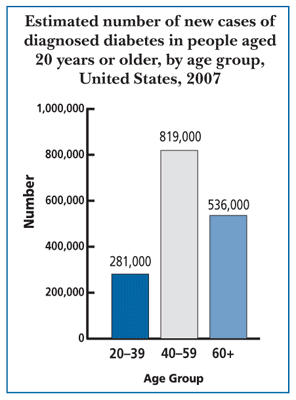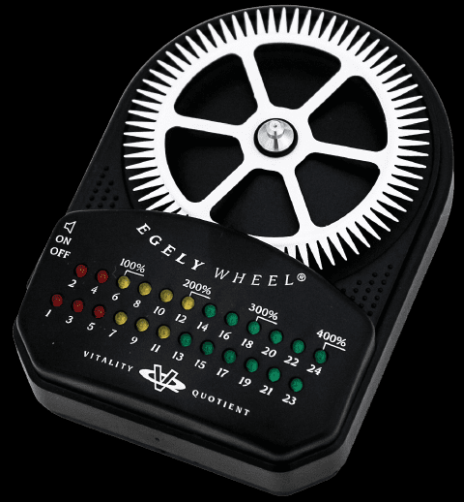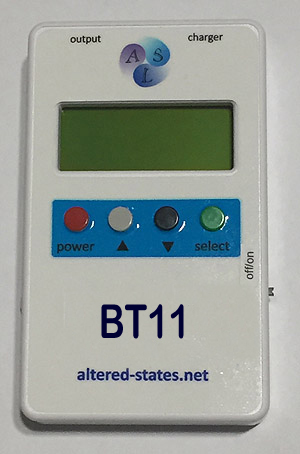Diabetes System
NZ$1,192.93
Approx USD$695.00

Diabetes has become so prevalent that
some concerned health care providers and officials have
labeled it, along with obesity, as one of the "plagues" of
the 21st century. According to the American Diabetes
Association (ADA), the number of Americans with diabetes
tripled between 1960 and 1990, then doubled again between
1990 and 2000.
| Although there are several types of diabetes,
the most common form is type 2, which results
when the body either does not produce enough
insulin (a hormone that allows glucose to enter
cells) or fails to utilize insulin properly.
Approximately 90 percent of all people with diabetes
have type 2 diabetes. Left untreated, it can
case a wide range of related health problems,
including heart disease; blindness; kidney failure;
nerve damage; and poor blood circulation. |
U.S. newspapers continuously report the
increase in the number of individuals among all age
groups who suffer from diabetes.

How can acupuncture
help diabetic patients?
Diabetes is caused primarily by dysfunction of the
pancreas. Scientific studies and clinical tests in
international research centers in the past 10 years*
have shown that acupuncture can help diabetic patients
in the following ways:

 lower
blood glucose content;
lower
blood glucose content;
 lower
the release of pancreatic glucagons;
lower
the release of pancreatic glucagons;
 attenuate
symptoms of polyphagia (the urge to eat too much), polydipsia
(excessive thirst) and polyuria (excessive passage of urine);
attenuate
symptoms of polyphagia (the urge to eat too much), polydipsia
(excessive thirst) and polyuria (excessive passage of urine);
 prevent
slowing of motor nerve conduction;
prevent
slowing of motor nerve conduction;
 improve
microcirculation and myocardial contractility;
improve
microcirculation and myocardial contractility;
 enhance
blood outflow and regulate vascular peripheral resistance;
enhance
blood outflow and regulate vascular peripheral resistance;
 exert
anti atherogenic, antioxidant and immunomodulating effects;
exert
anti atherogenic, antioxidant and immunomodulating effects;
 obliterate
antheroscelerosis of the legs;
obliterate
antheroscelerosis of the legs;
 induce
secretion of endogenous beta-endorphin;
induce
secretion of endogenous beta-endorphin;
 elevate
a lowered pain threshold; and
elevate
a lowered pain threshold; and
 increase
cell proliferation and neuropeptide Y levels.
increase
cell proliferation and neuropeptide Y levels.
TREATMENT OF DIABETES WITH
CHINESE HERBS AND ACUPUNCTURE
Lowering Blood Sugar
Subhuti Dharmananda, Ph.D., Director, Institute for
Traditional Medicine, Portland, Oregon
BRIEF HISTORY OF CHINESE MEDICINE AND DIABETES
Chinese medicine owes its current stature to the long history of its
practice, dating back more than 2,000 years in a form similar to that
utilized today. Chinese physicians appear to have had a reasonably
good understanding of diabetes since ancient times. In one of the oldest
books about Chinese medical theory, the Huangdi
Neijing , compiled around 100 B.C., the condition known
as xiaoke is mentioned. This is translated today as diabetes or diabetic
exhaustion. The literal translation of the term is emaciation-thirst,
referring to the disease manifestation when it has gone untreated:
namely, one loses body weight despite eating normally, and thirst is
persistent. According to this ancient text, the syndrome arises from
consuming too much fatty, sweet, or rich food. It is said that it typically
occurs among wealthy people: "you ask them to refrain from a rich
diet, advice which they may resist." The description fits that
of non-insulin-dependent diabetes mellitus.
 More
than 220 million people worldwide have diabetes. More
than 220 million people worldwide have diabetes.
 In
2005, an estimated 1.1 million people died from
diabetes.1 In
2005, an estimated 1.1 million people died from
diabetes.1
 Almost
80% of diabetes deaths occur in low- and middle-income
countries. Almost
80% of diabetes deaths occur in low- and middle-income
countries.
 Almost
half of diabetes deaths occur in people under
the age of 70 years; 55% of diabetes deaths are
in women. Almost
half of diabetes deaths occur in people under
the age of 70 years; 55% of diabetes deaths are
in women.
 WHO
projects that diabetes deaths will double between 2005
and 2030. WHO
projects that diabetes deaths will double between 2005
and 2030.
 Healthy
diet, regular physical activity, maintaining a normal
body weight and avoiding tobacco use can prevent or delay
the onset of diabetes. Healthy
diet, regular physical activity, maintaining a normal
body weight and avoiding tobacco use can prevent or delay
the onset of diabetes.
WHO (World health organization) |
Diabetes is a major health problem worldwide,
but particularly in America. It is estimated that about
2.1% of the world's population has diabetes, but the
disease is out of control in America. In the U.S.,
current estimates are that over 6% of the adult population
has the disease, 99% of them with the type 2 diabetes
mellitus (late onset or non-insulin-dependent: NIDDM).
Type 2 diabetes usually appears around the age of 50
or later, though it can occur during teen years in
some cases of obesity. The incidence rate becomes quite
high among elderly Americans (20% for those over the
age of 65) and in groups with genetic or other predispositions
including blacks (14%), Hispanics (15%), and Native
Americans (19%). Furthermore, the overall incidence
of diabetes is growing, apparently because of increased
rates of obesity.

| CDC data on prevalence of diabetes across
the United States in 1994 (left) and in 2000
(right). The rise in diabetes rates is striking.
In the year 2000, no states had less than 4%
of the population with diabetes, and only 10
states had under 5%. |
Despite the major medical advances in
rapid and easy monitoring of blood sugar and treatment
with drugs, diabetes remains a serious problem. Blood
sugar regulation that can be attained by standard methods,
particularly when patients are not fully compliant
with all medical recommendations, is often not adequate
to avoid common secondary effects of diabetes, including
cardiovascular diseases, degenerative eye conditions,
limb numbness and pain, skin ulceration, and kidney
failure. Thus, investigating other avenues for aiding
the treatment of diabetes and its secondary consequences
is an important undertaking.
Acupuncture can stabilize blood sugar,
correct insulin imbalances and aid in the treatment
of Type II Diabetes or its earlier stages of
Metabolic Syndrome
Dubai Wellbeing Center conducted a small
study of diabetes in the United Arab Emirates
and found that acupuncture was a successful
treatment for the disease
Among the 22 participants who took usual
Diabetes-prescribed drugs, there were 12
cases rated as effectively treated and 8
cases as markedly effective. However 20 of
them showed serious side effects such as
kidney malfunction. On the acupuncture group
27 patients were treated successful and 11
needed more treatment. However none of the
38 patients showed any side effect.
.Source |
ACUPUNCTURE
FOR DIABETES
Acupuncture therapy
is a common approach to treating diabetes in China.
Many Americans assume that acupuncture is only suitable
for treating pain, perhaps because the initial introduction
of acupuncture was mainly for this application. Indeed,
the general opinion here appears to be that acupuncture
ought to be used mainly for treating chronic back pain.
Therefore, relatively few people have turned to acupuncture
for treating the disease. Increasingly, people with
pain and other health problems for which acupuncture
is selected also have diabetes.
| Acupuncturists have identified about 20 points
on the body that appear to be effective in lowering
blood sugar; typically, a dozen of these points
are selected for treatment at one time. Western
cultures as a result of the increasing acceptance
of Chinese medicine during the past three decades. |
A report in the 1994 Journal of Traditional Chinese
Medicine (37) serves as a model of Chinese research
on acupuncture. The researchers recruited 60 patients
with diabetes and divided them randomly into two groups:
the acupuncture group (38 patients) and the control
group (22 patients); the two groups were found to be
well matched for symptoms and laboratory results (blood
and urine tests). Both groups followed a regulated
diet during the study, but one group received acupuncture.
To evaluate the effects of treatment, three levels
of responses were defined. Patients who experienced
markedly effective results were those who had their
initial symptoms essentially disappear by the end of
the one month treatment and their fasting blood-sugar
levels had dropped below 130 (or the blood sugar two
hours after a meal would be below 150). Further, the
24-hour, urine-sugar content was reduced by 30% or
more at the end of treatment compared to beginning
of treatment.
What are
common consequences of diabetes?
Over time, diabetes can damage
the heart, blood vessels, eyes, kidneys, and nerves.
 Diabetes
increases the risk of heart disease and stroke.
50% of people with diabetes die of cardiovascular
disease (primarily heart disease and stroke). Diabetes
increases the risk of heart disease and stroke.
50% of people with diabetes die of cardiovascular
disease (primarily heart disease and stroke).
 Combined
with reduced blood flow, neuropathy in the feet increases
the chance of foot ulcers and eventual limb amputation. Combined
with reduced blood flow, neuropathy in the feet increases
the chance of foot ulcers and eventual limb amputation.
 Diabetic
retinopathy is an important cause of blindness,
and occurs as a result of long-term accumulated
damage to the small blood vessels in the
retina. After 15 years of diabetes, approximately
2% of people become blind, and about 10%
develop severe visual impairment. Diabetic
retinopathy is an important cause of blindness,
and occurs as a result of long-term accumulated
damage to the small blood vessels in the
retina. After 15 years of diabetes, approximately
2% of people become blind, and about 10%
develop severe visual impairment.
 Diabetes
is among the leading causes of kidney failure.
10-20% of people with diabetes die of kidney
failure. Diabetes
is among the leading causes of kidney failure.
10-20% of people with diabetes die of kidney
failure.
 Diabetic
neuropathy is damage to the nerves as a result
of diabetes, and affects up to 50% of people
with diabetes. Although many different problems
can occur as a result of diabetic neuropathy,
common symptoms are tingling, pain, numbness,
or weakness in the feet and hands. Diabetic
neuropathy is damage to the nerves as a result
of diabetes, and affects up to 50% of people
with diabetes. Although many different problems
can occur as a result of diabetic neuropathy,
common symptoms are tingling, pain, numbness,
or weakness in the feet and hands.
 The
overall risk of dying among people with diabetes
is at least double the risk of their peers
without diabetes. The
overall risk of dying among people with diabetes
is at least double the risk of their peers
without diabetes.
|
For the 38 participants in the acupuncture
group, there were 25 cases rated markedly effective
and 10 cases rated effective: nearly 2/3 of the patients
treated showed marked improvement and only three patients
failed to respond. Further, it was reported that the
patients receiving acupuncture experienced a statistically
significant decline in cholesterol, triglycerides,
and beta-lipoproteins. The drop in triglycerides was
most substantial, with a decline from an average value
of 151 at the start to 117 one month later (a decline
of more than 20%). There were significant improvements
in "nail-fold microcirculation," which is
a measurement of blood circulation through capillary
beds (poor circulation through these beds is one reason
persons with diabetes suffer from skin ulceration),
which has also been observed in other diabetes studies
(11, 12). Among those who were using insulin, the amount
needed after the 30 days of acupuncture declined in
six of the eight individuals; in two of those cases,
the insulin could be stopped altogether.
In the U.S., it is uncommon for people to
receive acupuncture therapy every day, as is
the method used in the clinical studies reported
in the Chinese medical journals. Instead, one
may undertake a course of therapy with acupuncture
once or twice per week. Needless to say, the
impact of the intermittent treatment is not as
great as with daily acupuncture.
You can now |
No
Needles
Introducing
the DJT-4T
Diabetes Treatment Instrument
Now
available in the west

DJT-4T Diabetes Treatment Instrument
is one of the latest products using a series of low
frequencies . In combination with traditional Chinese
acupuncture, channels & meridians, and modern electronic
acupuncture holographic reflex theory. The equipment
is listed as safe and durable, with no piercing of
the skin, no side effect, and totally overall natural
therapy.
The Low Frequency Diabetes Treatment
Instrument provides holographic reflex therapy through
the accupoints, readjusting the function of the pancreas
and the endocrine system by strengthening the cells
biological vitality, as a result normalizing the synthesis
and secretion of insulin, so as to make blood sugar
and urine sugar adjust back to normal levels. Different
from the temporary treatment of western medicine, Huahan
low frequency accupoint stimulator is aimed at being
a permanent solution dedicated to restoring the balanced
of the pancreas.
 Type-1
diabetes: Reported to help prevent and control complications;
Type-1
diabetes: Reported to help prevent and control complications;
 Type-2
diabetes: Not only Reported to help prevent and control complications,
more importantly, could reduce the dosage of medication or insulin
injection, in china, if glucose level is between 6-7.5mmol/l, some
patient using DJT-4T three times daily. have reported a decrease
in their blood glucose to a normal value,
Type-2
diabetes: Not only Reported to help prevent and control complications,
more importantly, could reduce the dosage of medication or insulin
injection, in china, if glucose level is between 6-7.5mmol/l, some
patient using DJT-4T three times daily. have reported a decrease
in their blood glucose to a normal value,
More
than 20 years history, the No.1 brand of Chinese
electro acupuncture
 How
it works The
DJT-4T emits
three different audio pulse waves as sparse
and dense,continuous and intermediate,which
work alternatively to stimulate the acupoints
in ear, hand, foot and body, which could be
transmitted to the corresponding organs,thus
activating the vitality of the cells , increasing
the blood circulation,improving the immune
system, adjusting the endocrine system, strengthening
the metabolism, keeping your body in a balanced
state.
How
it works The
DJT-4T emits
three different audio pulse waves as sparse
and dense,continuous and intermediate,which
work alternatively to stimulate the acupoints
in ear, hand, foot and body, which could be
transmitted to the corresponding organs,thus
activating the vitality of the cells , increasing
the blood circulation,improving the immune
system, adjusting the endocrine system, strengthening
the metabolism, keeping your body in a balanced
state.
 Use
DJT-4T Usage: 30-40 mins per time, 2-3 times daily
.
Use
DJT-4T Usage: 30-40 mins per time, 2-3 times daily
.
 Symmetrical
and dissymmetrical impulse waves as sparse & dense,
spiccato and continuous forms
Symmetrical
and dissymmetrical impulse waves as sparse & dense,
spiccato and continuous forms
 Take
medicine and insulin together with DJT-4T, both symptom
and cause solution, you'll find very interesting treatment
results.
Take
medicine and insulin together with DJT-4T, both symptom
and cause solution, you'll find very interesting treatment
results.
 Diabetes
Treatment Instrument
Diabetes
Treatment Instrument
 Physical
therapy medical equipment
Physical
therapy medical equipment
 This
medical instrument has three functions: Diabetes
Treatment, Health care, Facial Rejuvenation
This
medical instrument has three functions: Diabetes
Treatment, Health care, Facial Rejuvenation
 For
multiple users on home basis
For
multiple users on home basis
 Ear,
hand palm, foot ,body, SPA Therapy
Ear,
hand palm, foot ,body, SPA Therapy
Accessories
Main Instrument 1 Set
Diagnosis and treatment 6 Pieces
1.Auricular Mould 2 Sets (XL, L, M, S)
2.Clamp
3.Ear Acupoints model 1 Piece
4.Self-adhesive electrode pad 6 Pairs
5.Electrode insole 3 Pairs
6.Hand palm electrode 6 Pieces
..Operation manual 1 Copy
..Warranty card 1 Copy
|
Clinical
Trial Report on DJT-4T
Diabetes Treatment Instrument
The instrument under clinical trial
is DJT-4T, one of product series of HUA HAN ZHEN
SHEN® diagnosis and treatment instruments, which is
in accordance with YZB/Shaan0110-2008
Registered Product Standards, and has won the
latest self-testing report issued by its
subordinate production enterprise as well as
the qualified registration inspection reports
issued by Tianjin Product Quality Inspection
centre and Guangdong Medical Devices Quality
Surveillance and Test Institute.
Comparative
analysis
61 cases adopted from 62
planned cases sourced from endocrinology division
of First Affiliated
Hospital of Tianjin University of TCM and Second Affiliated Hospital
of Tianjin University of TCM. And
all patients have finished the period of treatment as requested
in trial program.
The First Affiliated Hospital
of Tianjin University of TCM
Clinical Trial Organization ( Seal ) Date: May19th,
2009
Conclusions
HUA HAN ZHEN SHEN® diabetes
treatment instrument DJT-4T helps to decrease
fasting blood
glucose and glycosylated hemoglobin of diabetics, with no side-effects
happening in the process of the
trial. more more |
No experience
in acupuncture or TCM is required to use this amazing
new machine
English
Manual
By adopting
and implementing the international quality management
system EN ISO9001:2000, ISO13485:2003 and CE certificate,
Huahan always pursues the best quality product
and services for their clients








